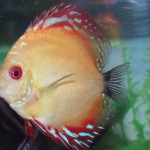Because fish originate from different bodies of water that have differing pH levels, there is not a common, or normal, pH that all fish can live in. Every fish has a different range of pH it enjoys to live in and balancing the water of your aquarium to a matching level will be very beneficial for your fish to strive. Remember that even with careful control of the aquariums pH, that the pH is not a static number. It is constantly changing due to the vast amount of influences on he tank. During the day the pH will rise, and fall later that night. PH change when fish are brought into or removed from the tank, it will change when fresher water is added, and will change depending upon the quantity of biological processes your fish go through each day.
Despite the varying levels in the tank, it is still perfectly acceptable for the tank to be within a certain range of pH that the fish of the aquarium can live comfortably in. These pH levels, which can be influenced and controlled by the owner, are important to be aware of. Each freshwater fish thrives in a separate, even if similar, range which allows you to place separate breeds of fish with similar pH tolerances in the aquarium. The following is a list of common freshwater fish and their accepted pH tolerances: Angelfish 6.5-7.0, Clown Loach, 6.0-6.5, Goldfish 7.0-7.5, Harlequin 6.0-6.5, Hachetfish 6.0-7.0, Neon Tetra 5.8-6.2, Plecostomus 5.0-7.0, Silver Dollar 6.0-7.0, Tiger Barb 6.0-6.5, and Zebra Danio 6.5-7.0.
The most important factor about maintaining a proper pH level in the tank is that sudden rapid changes in the pH of the tank can be fatal for the fish. This is because that a sudden change in pH results in the release of differing chemicals, with the most important to your fish being the release of ammonia into the tank as too much ammonia in the tank will turn the water toxic. During the break-in of a new tank, the pH is especially important to monitor as the changes are harder for young or sick fish to cope with. Another important note on maintaining a proper pH is that in most fish, breeding only occurs inside a small pH range.
In an effort to maintain a stable pH in your aquarium, check the pH at least once a month. It suggested that you check it more often than that, such as every two weeks, and also keep a log book of the test results for ease reference in the future. Make a schedule for this pH testing, and try to test your water at the same time of day each test as testing at different times of the day can skew the results even when there is not a problem in the tank. If a fish seems ill or happens to die, test the pH as a possible cause. If you are going to treat the tank, test the pH prior to the treatment period, test on the final treatment day, and test the water a week after this treatment period. Also test your water prior to acquiring a new fish and ask about the water of the tank the fish was in from where you purchased it. Ideally, these two pH levels will be similar to ensure minimum chance of problems when you introduce this new fish to your aquarium.
With proper monitoring and maintenance, the pH of your aquarium should not be that hard to keep at a stable level for your fish to live a happy healthy life in. Proactive water care is the best solution to thus, with refreshing your water and gravel vacuuming being two of the best ways to keep a stable pH. Always remember that even if the test result isn’t perfect for the suggested range, if the pH is stable and your fish seems to be healthy to just leave the pH at that natural level.
















